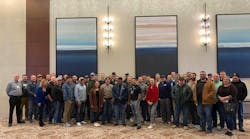As the 21st century dawns, the march...no, not the march...the Indianapolis 500 of new technology continues unabated. It is sometimes a good thing to stop and take a look back. To not only get a sense of how much, and how quickly, the trade has changed over just the last 50 or so years, but how we can take advantage of those changes. The inception of the “digital age” has wrought changes to our world that even the most forward-thinking nerds could not have envisioned.
As far as plumbing and pipefitting is concerned, it does not take too much imagination to follow the genesis of our trade from “don’t drink downstream from the herd,” to laser macerating toilets (something which is on the drawing boards as I write).
On the island of Crete, the palace of King Minos at Knossos had hot and cold running water as well as an elaborate water collection and drainage, waste and vent system complete with both clay waste piping and lead water piping...5,000 years ago! Look it up! You will see some of the most amazing examples of our craft ever found.
The trade’s gradual ascent, decline and reemergence over that time is a mirror of civilization itself. The destruction of Knossos, and with it the Minoan civilization in 1,500 B.C.E. by volcanic eruption, the advent of social, sanitary plumbing (of a sort) 1,500 years later in the Roman era, the decline of western civilization during the dark ages, the black plague, the Renaissance, the Portugese, Spanish, British, French, Dutch, Chinese, Russian, Japanese, German and American dominance on the world stage is also the story of the plumbing trade. Technical innovations have been adopted and adapted by plumbers for thousands of years. Not all of the ‘new’ technology worked as described, but what did work moved the trade and civilization ahead, as it was folded into the trade and built upon.
Let’s agree that what we do, for the most part, is not rocket science. Today, we deal with known quantities and how they work: solids, liquids, gasses, heat, cold, gravity, pressure...all settled science. As science, or trial-and-error, “discovered” the principles of how and what these various parts worked and did, techniques and systems for the installation and utilization of them developed. Once we understood how, for example, to use venting to make drainage work better or use gravity to increase water pressure, innovation of the methods followed.
The growth and sophistication of the plumbing trade had been slow and fairly steady. A pipe is a pipe, a valve is a valve, a fixture or piece of equipment does whatever it was designed or invented to do. Craftsmanship developed and was nurtured over time to address the installation and maintenance of plumbing systems. Specialized training was taught to “selected” apprentices with the intent that they carry on the trade in addition to making a living by working at it. In the past, such training was a closely held secret and revealing such “trade” secrets could result not only in ostracism, but in physical punishment or even death to the miscreant.
The surge of innovation does not look like it will crest anytime in the foreseeable future.
It was not so many years ago that children and young adults were indentured (a nice way to say made into a slave) to a tradesman for years in order that they be taught the trade. A parent could give a child to a tradesman, or the young adult could ask to be indentured. This was a serious commitment and such a verbal contract was enforceable under law.
Because the innovations in materials and methods moved at a slow pace, it was easy to quantify and qualify what we did into codes and rules. Resistance to new methods and technology came not from the plumber or craftsman, but from the government entities whose turf it was to regulate such things. Sometimes, in fact most times, regulatory resistance to new technology was an exercise in political power, rather than an objection to the new thing or method on technical grounds. On a personal note, this has been true throughout the lifetime of my granddad, my father and, up until recently, mine. I say up until recently, because the “regulating authorities” and other powers that be have embraced new technology like never before in the past few decades.
In years past, going from being allowed by the municipality to use galvanized steel, threaded and coupled pipe for potable water to using red brass was a fight. Going from red brass to soldered copper tube was the equivalent of a battle from, say, the Civil War. Likewise going from 5’ lengths of single hub cast iron for DWV to 10’ lengths was a skirmish, but going from that to No-Hub was like Gettysburg all over again. These arguments revolved around trade craft, primarily. Joe Homeowner could install No-Hub easily, but not hub and spigot. Once copper was allowed and proven for potable water piping, plastic tubing was, likewise, given short shrift by the municipalities until enough pressure was brought to bear from the manufacturers for that product to be allowed. Again, craftsmen were the losers because anyone can cut and glue plastic, let alone install PEX. Fixtures were not immune either. Ten years ago, the City of Phoenix would not allow waterless urinals to be installed. The reasoning was what it was then, but today those same urinals are now installed in Phoenix regularly.
At the pace new technology is advancing, and the almost universal acceptance of that technology by the powers that be, the surge of innovation does not look like it will crest anytime in the foreseeable future. If you are in the trade today, my advice to you is to embrace that technology cautiously. Sometimes a new thing can bite you if you are not careful.
The thing is, regardless of the technology, keep your trade skills sharp and show excellence in your craftsmanship. Even though it may not seem so, there is still a good market for skilled tradesmen. Be one.
The Brooklyn, N.Y.-born author is a third-generation master plumber. He founded Sunflower Plumbing & Heating in Shirley, N.Y., in 1975 and A Professional Commercial Plumbing Inc. in Phoenix in 1980. He holds residential, commercial, industrial and solar plumbing licenses and is certified in welding, clean rooms, polypropylene gas fusion and medical gas piping. He can be reached at [email protected].









